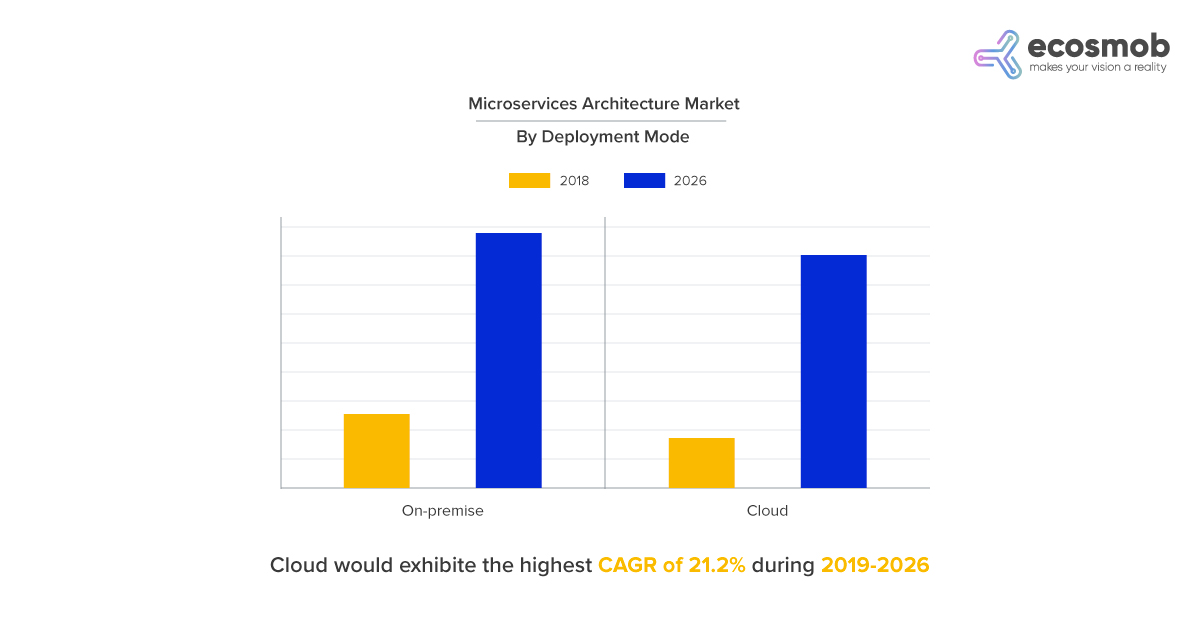Microservices are a software architecture in which a single application comprises multiple small, independently deployable services. Each service runs its process and communicates with other services through a lightweight mechanism, typically over HTTP/REST.
With Microservice Architecture, businesses can concentrate on tiny stand-alone services easily maintained by many smaller teams instead of focusing the entire team on a single extensive application. Hence, creating applications using this type of microservices paves the way for innovation and offers businesses various advantages that we will discuss later in the article.
From a global perspective, the Russia-Ukraine conflict hampered the chances of the world’s economy recovering from the COVID-19 pandemic. The war resulted in supply chain interruptions, a rise in commodity prices, and economic sanctions against numerous nations. It caused inflation in many markets worldwide and increased costs for products and services. Despite such roadblocks, the market size of microservices architecture is predicted to reach $10.86 billion in 2027 at a CAGR of 19.6%. (Report by- the business research company)
The emerging concept of microservices trends is gaining popularity. These microservices trends are becoming more common as businesses strive to move away from monolithic architecture and become more nimble.
This blog will introduce you to the top microservices trends, characteristics, and advantages. Let us first look briefly at them.
Characteristics of Web Applications With Microservices
Built Specially for Businesses
Each set meets a specific priority or solves a particular problem. Since small teams make different services, they can also focus on maintaining and running that service for its lifetime.
Independence
The microservices architecture enables each component’s development from a tightly coupled program without affecting another’s functioning. In this state of autonomy, service teams need not share any code or implementation process, thereby plugging any communication gap.
Check out A complete guide to understanding microservices architecture for some detailed insights on the driving forces of Microservices.
Simplicity
Microservices offer simplicity in development and maintenance. It is the reason why microservices are becoming popular with each passing day. By definition, any software built with microservices architecture can be broken down into multiple components. This feature makes it easier to modify or improvise on any isolated element and redeploy the entire software without worrying about other affected components.
Evolution
Large systems that once had complex monolithic structures will become more scalable and agile with the evolutionary design of Microservices. If broken down into smaller, microservices are very easy-to-run technologies.
Advantages of Microservices
Microservices offer a plethora of advantages. For instance,
- A relatively smaller group develops, designs, runs and maintains each set of microservices without interference from the other.
- A simplified development approach to microservices architecture will help newer team members understand the system quickly, reducing hand-holding time and facilitating a more efficient workspace.
- Modifying and improving microservices architecture is more accessible than a monolithic (almost outdated) program. Changes required in any part of the application can be made without disturbing the other areas. Similarly, if one microservice malfunctions, it will not stop the entire operation as the others will continue to work.
- Easy to integrate with third-party services.
- The other significant benefits of a microservices architecture are its expansion of corporate reach, support for consumer choice, transparency & enablement, and improvement of business time to market due to technological agility.
Top Microservices Trends of 2023
Enterprises are rapidly moving towards microservices architecture catering to end users in several industries. These may include retail, healthcare, IT, and telecommunications to provide solutions at their fingertips. With the increased use of connected devices like smartwatches, tablets, and fitness trackers, SaaS and PaaS-based enterprises have rapidly adopted cloud-based solutions.
In other words, the solutions segment – across industries – has seen the highest growth owing to the adoption of microservices architecture by businesses that are high on customer success. The widespread acceptance of microservices as the next big thing to help streamline web applications development processes is assisting organizations with faster development cycles, scalable and agile systems, and improved productivity with reduced costs.
Some of the several popular microservices trends have emerged in recent years, including:
1) Service Mesh
A service mesh is a reconfigurable infrastructure layer for a microservices application. It enhances observability by giving you insights –
- The behavior of your microservices
- Ability to control their communication
A service mesh typically includes:
- A data plane.
- A set of proxies that handle the actual communication between microservices.
- A control plane is responsible for configuring and managing the proxies.
- The proxies in the data plane handle tasks such as load balancing, service discovery, and traffic management and provide features such as service-to-service authentication, encryption, and observability.
Other Key Benefits of Service Mesh-
Improved security
Service meshes provide built-in security features such as service-to-service authentication, encryption, and access control, which helps to secure communication between microservices.
Better observability
A service mesh provides detailed metrics and tracing information that can be used to monitor and troubleshoot communication between microservices.
Improved reliability
A service mesh provides features such as automatic re-tries and circuit breaking, which can help improve communication between microservices’ reliability.
Flexibility
You can fine-grain the control over the communication between microservices and configure it to handle different types of traffic, such as North-South and East-West traffic.
Platform independence
This technology is platform agnostic and can run on any infrastructure and with any programming language.
Service mesh technology provides robust features to help organizations. This is why it is becoming a popular trend in the microservices space.
2) Kubernetes
It is a popular platform for managing and deploying microservices. It provides several well-suited features to manage microservices, such as automatic service discovery, load balancing, and self-healing. Kubernetes also allows easy scaling of individual microservices and rolling updates and rollbacks of the application.
One of the advantages of using Kubernetes to manage microservices is that it abstracts away the underlying infrastructure, allowing developers to focus on their application code and not have to worry about the infrastructure details. This enables teams to work in parallel and release new features more frequently, resulting in faster time-to-market and better customer satisfaction.
3) Artificial Intelligence Operations (AIOps)
AIOps uses artificial intelligence (AI) and machine learning (ML) techniques to automate and optimize IT operations, such as monitoring, incident response, and capacity planning. It allows organizations to manage and automate the operations of their microservices more effectively.
In the context of microservices, AIOps can be used to:
-
Automate monitoring and incident response-
AIOps can automatically detect and respond to issues in microservices, such as detecting and mitigating service outages, identifying and remediating performance issues, and detecting and blocking security threats.
-
Optimize resource usage-
AIOps can analyze resource usage patterns and recommend scaling microservices based on usage patterns.
-
Improve troubleshooting-
AIOps can be used to analyze log data and other operational data to identify the root cause of issues in microservices quickly.
-
Predictive capacity planning-
AIOps can predict future resource usage and capacity requirements for microservices, allowing organizations to plan for and manage capacity proactively.
-
Automated deployment-
AIOps can automate the deployment of microservices, such as automating the scaling and rollouts of new versions of services.
Overall, AIOps help organizations to manage and automate their operations more effectively.
4) API Management
In a microservices architecture, multiple services work together to complete a task, each service has its own set of functionalities, and they communicate with each other through APIs.
Simply put, microservices rely heavily on APIs to communicate with each other.
It provides a set of tools and capabilities to manage and secure these APIs, such as:
API Gateway – Incoming requests are forwarded to the proper microservice by an API gateway, which handles authentication, rate restriction, and caching.
Security – API management solutions provide a range of security features, such as authentication, authorization, encryption, and access control, to secure communication between microservices and ensure that only authorized clients can access the APIs.
Analytics and monitoring – API management solutions provide analytics and monitoring capabilities, such as tracking usage patterns and identifying performance bottlenecks, to help organizations understand how their APIs are being used and identify potential issues.
Developer portal – A developer portal provides a centralized place to access documentation, test the APIs, and access analytics data.
Versioning– API management solutions provide the ability to version APIs, allowing for different versions of an API to be used by other clients.
Overall, API management plays a vital role in a microservices architecture. It ensures that communication between microservices is secure, reliable, and scalable.
5) Serverless Architecture
Serverless architecture is a trend in MIrcroservices in which applications and services are built and run without the need to provision or manage servers. Instead, the cloud provider collects the underlying infrastructure, scaling, and availability.
Combining serverless architecture with microservices allows developers to build, deploy and run small, independent, and autonomous services easily scaled and managed by the cloud provider. This allows for greater flexibility, scalability, and cost savings, as well as improved resilience and fault tolerance.
6) Cloud Adoption
The growing popularity of cloud-based applications is offering more opportunities for customer-oriented businesses. Even as the pandemic accelerated cloud adoption, we are no strangers to the increasing dependence on cloud solutions in modern workplaces.
Organizations are transitioning to the multi-cloud strategy using the microservices architecture. While taking care of specific organizational needs, this approach also proves cost-effective. It also helps avoid dependence on a single source of software development, as microservices are essentially smaller components pieced together to make an extensive software program.
A report by Gartner predicts that by 2025, 90% of businesses will adopt a multi-cloud approach to run their businesses more efficiently and with reduced costs. Enterprise mobility will be another advantage for most enterprises as cloud adoption via microservices architecture will provide the necessary connectivity, agility, and scalability.
However, businesses must optimize costs, especially while adopting the multi-cloud approach. While a particular mix of microservice architecture and cloud adoption will help cut costs, it is essential to know that public cloud adoption expenses can quickly spiral and are hard to control if not monitored closely. Careful management is the key to keeping costs in check.
7) Observability Tools
After setting up a microservices architecture for an enterprise, the next step is identifying tools that help check its health. The said system might have several operational challenges that give the end user a seamless experience. A robust observability framework is vital for the smooth running of your system.
The year 2023 will see a growth in tools that will help keep track of logs, metrics, and traces of an organization’s microservices data. Several APM (Application Performance Management) tools will help developer teams understand telemetry data, storage backend, and microservices deployment.
Here are a few tools to keep track of your microservices architecture health:
- SigNoz
- Grafana Labs
- Honeycomb
- Instana
- Lightstep
- Dynatrace
- Datadog
- Splunk
- New Relic
- Sentry
8) Frameworks for Web Services
Choosing an appropriate framework to develop a microservices architecture for an enterprise. While selecting, developers will highlight the aspects that should be considered as a trend in the coming year.
As a developer, you must consider the criteria for selecting a suitable framework. Identifying the application’s requirements and planning and organizing its segments into smaller functions is the first step in that direction. A framework should be selected without changing its core features, considering that the application needs to be subdivided into individual components.
Appointing teams that can work independently but collaborate on a need basis is another critical requirement for choosing the best framework. The groups should have the required skills and tools for developing, deploying, and managing their specified service.
Here are some popular microservices frameworks for efficient microservices architecture:
- Spring Boot
- Eclipse Vert.X
- Oracle Helidon
- GoMicro
- Molecular
Conclusion
For better or for worse, microservices have become the default choice for many, if not all, businesses. In the case of enterprises with independent teams, microservices architecture can work well in the larger sense. However, the downside is that it is not without the complications that a distributed system brings.
As far as the current and future trend in a microservice architecture is concerned, it is a great time to be around! A trend that will also pick up soon is the shift toward serverless computing. While Microservice has existed for over a decade, it is only now that enterprises are beginning to embrace its benefits. With no burden of infrastructure management, saving on costs is an added advantage.
















